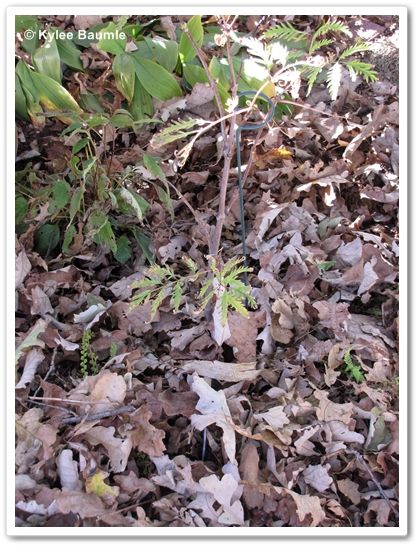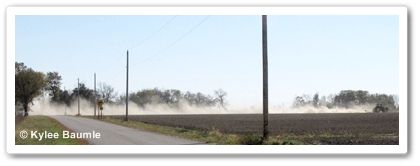When I’m in the garden, I ponder things. Sometimes it’s garden related. Sometimes it’s not. Today, I was removing leaves from around the plants in several beds so I could water. This brought to mind several things: the drought we’re experiencing, the leaf fall, and the cycle of life according to nature’s timing and plan. It got pretty deep out there – so deep that I had to come in and put it on virtual paper.
I had a conversation on Twitter recently with my friend Carole, at Ecosystemgardening.com about letting fall’s leaves…well…fall where they may, and leaving them there. As a 33-year homeowner of an acre of land, with no less than 92 deciduous trees, including several large oaks that are over 200 years old, leaves can be a big issue. And that doesn’t include the deciduous shrubs, the hundreds of perennials, or the neighbor’s trees that hang over our property and deposit their leaves here, right on top of ours.
We’re drowning in leaves.
We LOVE leaves; don’t get me wrong. It’s just that we have too much of a good thing this time of the year. We have a compost bin and several times during autumn, it gets filled to the brim with leaves, both whole and chopped. And we still have too many.
 |
| In addition to shredded hardwood mulch (to be added later), natural leaf cover will help protect the roses from winter's cold. |
 |
| There are four Tatting Fern (Athyrium filix-femina 'Frizelliae) plants under this thick layer of leaves that are struggling and desperately need moisture. |
Yes, I’ve given thought to what occurs naturally in nature. And I do many things according to the logic that nature follows. I sow many seeds when they would fall on their own – for example, columbine. The seeds fall naturally from the seed pods on the plants around late July and August. This allows them enough warm weather to germinate and get established. This is important, because columbine rarely blooms in its first year. If they’re allowed to get a start in late summer/early fall, the next year they may be large enough to bloom.
But the purpose of my garden task today was to remove the heavy leaf cover (round three, so far this fall) so that I could water the plants. We haven’t had any measurable rainfall for nearly three months. Just 15 miles south of us, the grass is green and they have no idea why we’re crying for rain here. It’s almost like there’s an invisible umbrella over our area.
 |
| The dust trail that stretches out behind this tractor attests to the dryness we're experiencing. |
If I’d tried to water the plants with the leaf cover, not a drop of it would have gotten to the soil and down to the roots where the plants need it. The dry leaves would absorb a lot of it, plus cause most of it to run off, away from the plants. I try to direct the water wand close to the ground, around the stems of the plants, but with the volume of plants here, it would be several day’s work just to do it once for each plant.
These plants need moisture and they need it badly. Even with intervention, we’ll likely lose plants by the time next spring rolls around, if not before. I garden for my own enjoyment, as well as that of the wildlife that calls Our Little Acre home, and we have plenty of that. But as stewards of what we’ve been given, sometimes we need to take action.
 |
| A tiny Hummingbird Moth caterpillar munches on the honeysuckle. |
During the beginning of construction of our new conservatory, holes were dug for the foundation. At 30 inches, it was thought that they hit rock. They persisted in their efforts and eventually broke through the HARD, DRY CLAY, continuing down to a depth of 36 inches. Even at that level, no moisture whatsoever was to be found. The soil was powder dry. Not good.
In the woods, no doubt extremes occur, too. Plants die all the time. But nature’s timetable is a whole lot longer than mine. I don’t have a couple of lifetimes to wait for nature to restore itself. Most home gardeners are controlling their immediate surroundings to some extent in that they plant for landscaping, they plant because they like the appearance of certain flowers, and they plant to raise their own food. I don’t think I’ve ever seen tomatoes, broccoli, onions, and green beans growing together without having had help in getting there.
We can plant for nature’s sake, too. We know what the butterflies like and we try to accommodate them. Personally, I like having a large variety of plants, both native and non-native, so as to create a wide diversity on our property. I feel that the insect population can be controlled for the most part by so many different plants attracting insects of all kinds – non-pests (called beneficials) and natural predators of those that are.
So while I try to use organic and natural methods as much as possible, and allow things to run their own course, sometimes nature needs a little help from those of us who love it so much. It returns the favor a thousand-fold.
 |
| Hummingbird Moth (Hemaris thysbe) |
Carole, thanks for the always interesting conversations!
















 "Bejeweled"
"Bejeweled"



8 comments:
Lovely and informative post. It just wouldn't be FAll without fallen leaves. We've also had a very dry summer. I'm in the process of deep watering each of my 40 or so trees before the freeze comes. Some of them are showing signs of stress.
I am out with hose in hand every day trying to put enough water on plants so the winter won't kill them. This has been a summer to remember.
I have a 1/2 acre garden on the west slope of the Sierras...two Sycamore trees sit on the south side of my house that provide needed shade during summer...when the leaves fall, it is a pile...if I leave the leaves in the beds, they tend to harbor snails and slugs..so, to the compost they go...I try to time the leaf gathering when the compost pile is full (you know..dead branches, weeds,trimmings from summer, etc.)..I put the leaves on last as a covering (several inches thick)..the leaves insulate...and keep the weeds to a minimum.
Meredehuit ~ It's kind of scary, isn't it - this lack of moisture. Still no rain here and none predicted. :-( You're absolutely correct to help your trees by watering. Many things are showing signs of stress here, too.
Lisa ~ It sure has, Lisa! It's reminiscent of the summer of 1988 - another VERY dry one!
flowerman ~ Oh boy - those Sycamore leaves are BIG ones, too! Yes, absolutely they do provide a home for the snails and slugs and that's another reason I don't like to leave them around certain plants -like hostas! It's why I trim my hostas back in the fall, too.
There's a time and place for those leaves, for sure. :-)
Kylee, my friend, I always enjoy our conversations so much! I've been pondering this issue too. Each of us will make the best choices for the conditions in our garden. And what's up with the rain this year? We went the entire summer with absolutely no rain, and now it feels like we're going to get our annual allotment in a couple of weeks. This sure was a wacky year weather-wise, starting with the ungodly amount of snow we started the year off with.
Does anyone still burn leaves? As a little girl in the Midwest, one of my fond memories of Autumn was raking all the leaves into a pile & setting a big fire. Guess I was a firebug.
Hey, guess what? It is finally raining in So Cal! We are on Day#6 of pitter patter..
Kylee, I'm with you in wanting the benefit of leaves, but also wanting my struggling ornamentals to do well.
I have the opposite problem with leaves as you do. Because we get a ton of rain here, the leaves often mat down and cause rot to perennial plants during our six month-plus rainy season.
Also, as a professional maintenance gardener, I deal with a lot of very tidy landscapes with landscape fabric and nicely-added mulch. Leaving leaf litter on top basically creates growing conditions conducive to sprouting weed seeds!
But Carole's points are all excellent too. Wildlife is very important as and we humans take up more of their space, it's a lovely thing to do to give back in our gardens. And what we give them, they give back in adding joy and magic.
So it's a struggle. Thanks for your take on this.
Kylee, I have the same issue with leaves here in CT - just plain too many. Like you, I have an acre of property that is ringed by mature trees, many of them oaks. We rake, blow & mulch leaves and put them in a big pile for the city to take away and compost. That pickup usually happens mid-November but in most years there are still many, many leaves left on the trees. The ones that fall after the city pickup stay in the garden - some where they fall as a blanket for the winter and others get added to the compost pile. Unfortunately in my garden, when it comes to leaves, there is a problem with too much of a good thing!
Post a Comment